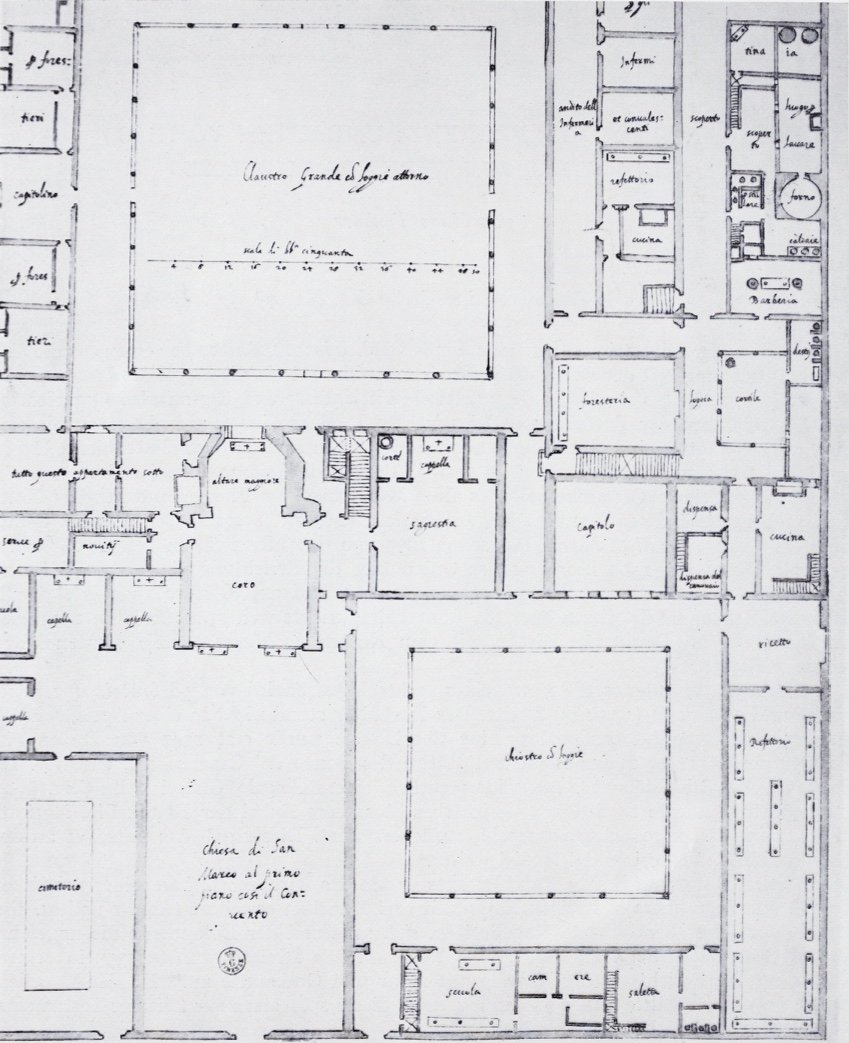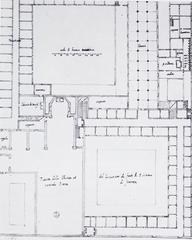
Convent of San Marco Florence: Visiting Hours, Tickets, and Historical Sites Guide
Date: 14/06/2025
Introduction
Nestled in Florence’s historic center, the Convent of San Marco stands as a landmark of religious, artistic, and architectural achievement. Once a medieval monastery, the site was transformed during the Renaissance under the patronage of Cosimo de’ Medici, with architect Michelozzo di Bartolomeo and the artist Fra Angelico leaving an indelible legacy. Today, San Marco presents a comprehensive journey through Florence’s cultural evolution, offering visitors a unique blend of architectural marvels, significant artworks, and profound spiritual history. This guide provides a detailed overview of the convent’s history, its must-see highlights, and practical information for visitors, including opening hours, ticketing options, accessibility, and travel tips. For further information, consult the Museo di San Marco website and other authoritative resources (Firenze Made in Tuscany, The Better Vacation, Summer in Italy).
Table of Contents
- Introduction
- Historical Background
- Architectural Significance
- Visitor Information
- Frequently Asked Questions (FAQ)
- Visual Resources and Media
- Conclusion and Visitor Tips
- References
Historical Background
Medieval Foundations
The origins of San Marco trace to the 13th century, when the Silvestrine monks established a monastery on the site (Firenze Made in Tuscany). This early convent experienced periods of decline, including damage by fire and the dispersal of art collections (European Traveler). The transition to Dominican stewardship in 1436, facilitated by Pope Eugene IV, set the stage for the site’s renewal (Fantastic Florence).
Renaissance Transformation
Cosimo de’ Medici’s patronage was pivotal. He commissioned Michelozzo di Bartolomeo to rebuild San Marco, implementing Renaissance ideals of harmony, symmetry, and light (The Geographical Cure). The new convent—with its two cloisters, refectory, library, and dormitory cells—was completed by 1443 and became a symbol of Medici influence and humanist learning.
Fra Angelico and Artistic Innovation
Fra Angelico, a Dominican friar and master painter, began his transformative work at San Marco in the 1440s (The Catholic Travel Guide). His luminous frescoes—most famously the “Annunciation”—adorn the corridors and 44 monks’ cells, offering spiritual meditation aids and exemplifying early Renaissance artistry (Florence Life). San Marco now houses the world’s largest collection of Fra Angelico’s works, including key paintings by Paolo Uccello, Ghirlandaio, and Fra Bartolomeo (Firenze Made in Tuscany).
Savonarola and Medici Influence
Cosimo de’ Medici maintained a personal cell at San Marco, reflecting both humility and Medici prestige. In the late 15th century, Girolamo Savonarola, the reformist Dominican prior, left a dramatic imprint on the convent and the city, orchestrating the “Bonfire of the Vanities” and briefly ruling Florence before his execution (Florence Life). His cell and personal belongings are preserved within the museum as historical artifacts.
Later Additions and Preservation
The bell tower, designed by Baccio d’Agnolo in 1512, and Donatello’s bronze bell—commissioned by Cosimo in 1435—add to the convent’s Renaissance treasures (Florence Life). In 1869, the site was converted into a museum, ensuring the preservation of its architectural and artistic heritage (Florencetips).
Architectural Significance
Michelozzo’s Design and the Cloisters
Michelozzo’s architectural innovations at San Marco established a model for Renaissance monastic design (The Better Vacation). The layout centers around the Cloister of Sant’Antonino, with harmonious proportions, rounded arches, and abundant natural light fostering a contemplative atmosphere.
The Church and Library
The basilica’s neoclassical façade, completed in 1777, adds later elegance to the complex (Tuscany Planet). Inside, the single nave and side chapels are adorned with works by Fra Angelico and contemporaries. The Michelozzo Library, one of Europe’s earliest public libraries, features a long vaulted hall and originally housed a vast collection of manuscripts, underscoring the convent’s role as a center of scholarship.
Artistic Integration
San Marco’s architecture and art are inseparable. Fra Angelico’s frescoes personalize each monk’s cell, while the refectory features Ghirlandaio’s “Last Supper.” The chapter house hosts Fra Angelico’s monumental “Crucifixion with Saints,” and the complex also preserves valuable illuminated manuscripts and relics.
Visitor Information
Opening Hours and Tickets
- Hours: The Museo di San Marco is open Tuesday to Sunday, typically 8:15 AM–1:50 PM. Closed Mondays and some holidays. The ticket office closes 30 minutes before museum closing time. Always check the official website for seasonal updates.
- Tickets: Standard admission is €8, with reduced rates for EU citizens aged 18–25 and free entry for those under 18. Tickets can be purchased online or at the entrance. Advance booking is recommended during high season.
Accessibility and Facilities
The museum is partially accessible; most main areas have ramps or elevators, but some historic sections may be challenging. Restrooms and a bookshop are available near the ticket office. There is no on-site café, but the surrounding area offers dining options (Summer in Italy).
Guided Tours and Etiquette
Guided tours (available in multiple languages) and audio guides enrich the visitor experience, providing deeper insight into the art and history of the convent (Made of Tuscany). Modest dress is required, with shoulders and knees covered, and a respectful, quiet demeanor is encouraged.
Travel Tips and Nearby Attractions
- Arrive Early: Early mornings are less crowded and offer a more peaceful atmosphere.
- Combine Visits: San Marco is close to the Accademia Gallery, Duomo, and other historical sites, making it ideal for a full day’s cultural itinerary.
- Photography: Non-flash photography is generally allowed except where otherwise indicated. Always observe signage.
Frequently Asked Questions (FAQ)
Q: What are the San Marco visiting hours?
A: The museum is open Tuesday–Sunday, 8:15 AM–1:50 PM, with last ticket entry 30 minutes before closing. Check for holiday exceptions.
Q: How much are tickets?
A: General admission is €8, with discounts for eligible visitors. Advance booking is advised.
Q: Are guided tours available?
A: Yes, guided tours in several languages and audio guides are offered.
Q: Is San Marco accessible for wheelchair users?
A: The site is partially accessible; contact the museum ahead for specific needs.
Q: Can I take photos?
A: Photography without flash is generally permitted, except in restricted areas.
Q: What are nearby attractions?
A: Accademia Gallery, Florence Cathedral (Duomo), and Piazza della Signoria are within walking distance.
Visual Resources and Media
- High-quality images of Fra Angelico’s Annunciation fresco (alt: “Fra Angelico Annunciation fresco at San Marco Florence”)
- The Cloister of St. Antonino (alt: “Cloister of St. Antonino, San Marco Florence”)
- Last Supper by Ghirlandaio (alt: “Ghirlandaio Last Supper fresco at San Marco”)
- Virtual tours and interactive maps are available through the official museum website and related platforms.
Conclusion and Visitor Tips
The Convent of San Marco stands as a testament to Florence’s Renaissance spirit, offering an unparalleled blend of art, architecture, and spirituality. With masterpieces by Fra Angelico, innovative design by Michelozzo, and deep ties to figures like Savonarola and Cosimo de’ Medici, San Marco remains an essential experience for any visitor to Florence. Plan ahead, arrive early, and consider guided tours to fully appreciate the rich history preserved within these walls.
For more information, download the Audiala app for guided tours and updates, and consult the official Museo di San Marco website and recommended guides (Firenze Made in Tuscany, The Better Vacation, Summer in Italy).
References and Further Reading
- Firenze Made in Tuscany
- European Traveler
- Fantastic Florence
- The Geographical Cure
- Tuscany Planet
- The Better Vacation
- The Catholic Travel Guide
- Visit Florence Italy
- Made of Tuscany
- Summer in Italy
- Florencetips
- Museo di San Marco website







































































